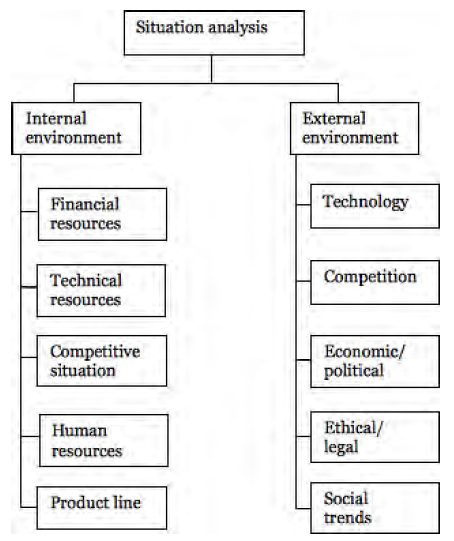When marketing organizations plan strategically, the key question is: "Does the strategic planning process raise the overall level of the organization's effectiveness, and does it provide the new strategic direction that is required for the future?" A good strategic plan must help marketing organizations recognize the interrelationships among various forces in the business environment. These interrelationships must be accounted for if the organization is to be capable of implementing its vision.
It is important to recognize that most existing planning processes have an internal focus. Internal planning processes ask questions like, "What are our strengths and weaknesses?", "What comparative cost advantages do we have?" and "What product features provide us with an advantage?"
The external planning approach asks these same questions but also attempts to understand how aII of the elements of the marketplace relate to each other. In this chapter, we focus on the external environmental factors that have an impact on the organization, especially the marketing function. In the chapters that follow, we consider the marketplace and its behavior.
As shown in Figure 5.1, marketing managers are confronted with many environmental concerns, including technology; customer; competitor; ethical/legal; and economic, political, demographic, and social trends. All organizations should continuously appraise their situation and adjust their strategy to adapt to the environment.

One technique used by organizations to monitor the environment is known as environmental scanning, which refers to activities directed toward obtaining information about events and trends that occur outside the organization and that can influence the organization's decision making. In a sense, such data collection scanning acts as an early warning system for the organization. It allows marketers to understand the current state of the environment and to predict trends. A formal but simple strategic information scanning system can enhance the effectiveness of the organization's environmental scanning efforts.1 An information system (part of marketing research) organizes the scanning effort so that information related to specific situations can be readily obtained and used.
A good strategic plan requires careful monitoring of the marketing organization's external environment. The external environment represents sources of opportunities and threats. If the marketing organization is to align its capabilities and resources with opportunities and threats, it must know what those threats are. It is important that marketing organizations have a strategy to uncover relevant strategic opportunities and threats early. As threats and opportunities appear, marketing organizations should develop strategies to deal with them.
Another problem is that at anyone time, there may appear to be a great many opportunities and threats looming. Marketers must be able to prioritize these opportunities and threats according to such factors as their relevance to the organization, the cost effectiveness of strategies to deal with the threats and opportunities, and the urgency of the threat or opportunity. Organizations are inundated with information and must therefore have an effective mechanism for sorting out that information which is relevant to the organization.
Only after the marketing environment is thoroughly understood can an organization spot trends and determine whether they represent market opportunities or market threats.
- 2528 reads






